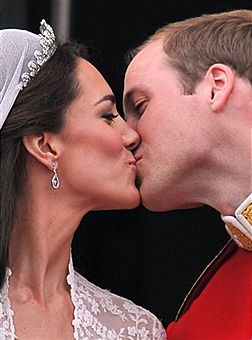 Here is a selection of articles on the Royal Wedding from around the web.
Here is a selection of articles on the Royal Wedding from around the web.
For those, like me, who wouldn’t know an Empire Line if it slapped them in the face, Vogue’s fashion live blog has all the details and photographs of what broadcasters have called a “festival of British fashion.”
Sam Cam was wearing a dress from Burberry, Princess Beatrice was bedecked in Vivienne Westwood and, the main event, Kate Middleton’s dress was made by Sarah Burton of Alexander McQueen. The Telegraph’s outgoing Fashion Editor, Hillary Alexander has more details here. It’s been quite a sales demonstration for Britain’s leading designers. Export led recovery here we come!
As Vanity Fair observes, the limelight was stolen briefly by Grace van Cutsem, Prince William’s goddaughter and one of the bridesmaids. Nicholas van Cutsem, Grace’s uncle, led the the Household Cavalry troop that accompanied the royal couple’s carriage from the abbey to the palace.
Dr Giles Fraser, Canon Chancellor of St. Paul’s, has written an article for the Mail explaining the bride’s choice of liturgy. Dr Fraser described the order of service as ‘not exactly authentic’ in a traditional sense: Parry’s I Was Glad, Guide Me O Thou Great Redeemer and Jerusalem mixing it with a new composition by John Rutter, Be Thou My Vision, as well as a prayer co-written by the Duke and Duchess of Cambridge read by the Lord Bishop of London, Richard Chartres. (Incidentally, the Dukedom of Cambridge is, according to the Mail, the highest ranking peerage in the land. Here is a list of previous royals who have held the title.)
In terms of the live coverage, it seems that Peter Hain was not alone in finding the BBC’s live coverage unsatisfactory. Harry Mount took issue with Huw Edwards’ presenting:
‘The real problem is that he clearly knows no more about the monarchy than most of the viewers. His comments are of the flipping obvious variety – “Here is the Duke of Edinburgh, smiling at the crowd.” What you need at times like these is someone like the BBC’s late Tom Fleming, who really knows his history and his royal facts. And he exists – he’s called Alastair Bruce, and he’s on Sky now; vastly more knowledgeable than Huw Edwards, he knows the history of every tiara, every monument on Whitehall, every button on every military uniform. Sky has won.’
So, is this pageant of any political or constitutional significance? As so often where such matters are concerned, the worthy Archbishop sounds the drum for High Church Tories:
‘God willing, this royal couple will one day be King William V and Queen Catherine of the United Kingdom of Great Britain and Northern Ireland. At that same moment, King William will also become the Supreme Governor of the Church of England, just as every monarch has been since Henry VIII. He will be the guardian of the Church’s authoritative formularies, its polity and its confessional identity of affirmation and restraint.’’
But others take a darker view. Writing in the pages of the Times (£), Dr David Starkey argues why this match
is evidence for what he terms a ‘divided nation’:
‘Marriage, which Kate and William are about to enter, is no longer the universal destiny it was. In my Fifties council estate, divorce, living together and illegitimacy were infre-quent in the extreme and viewed with horror. Now they are lifestyle choices and, for much of the population — including, until recently, the Leader of the Opposition — ac-tively to be preferred to marriage. Marriage, in other words, has become not a unifier but a divider. Kate and William, it is true, wanted to make their marriage “ordinary”. But their ordinary was not the ordinary of the Dales cottager of the Archbishop’s address in 1947. Instead, Kate and William’s notion of ordinary was a nice Sloaney wedding, with 200 ra-ra-ing chums in toppers, tails and fascinators in a sweet little Home Counties church, followed by a marquee re-ception at Papa’s City-bonus-bought country pile. No wonder the map of street parties looks like the present political map of Britain: thick on the ground where we vote Tory; thinner elsewhere and thinnest of all in Scotland. Behind the flummery of the dress, the cakes and the eco-forest in the aisle, is the real message of today that a national monarchy has become a Home Counties one; the symbol, not of the nation, but of comfortable Britain? I hope not. But I fear I may be right.’






Comments